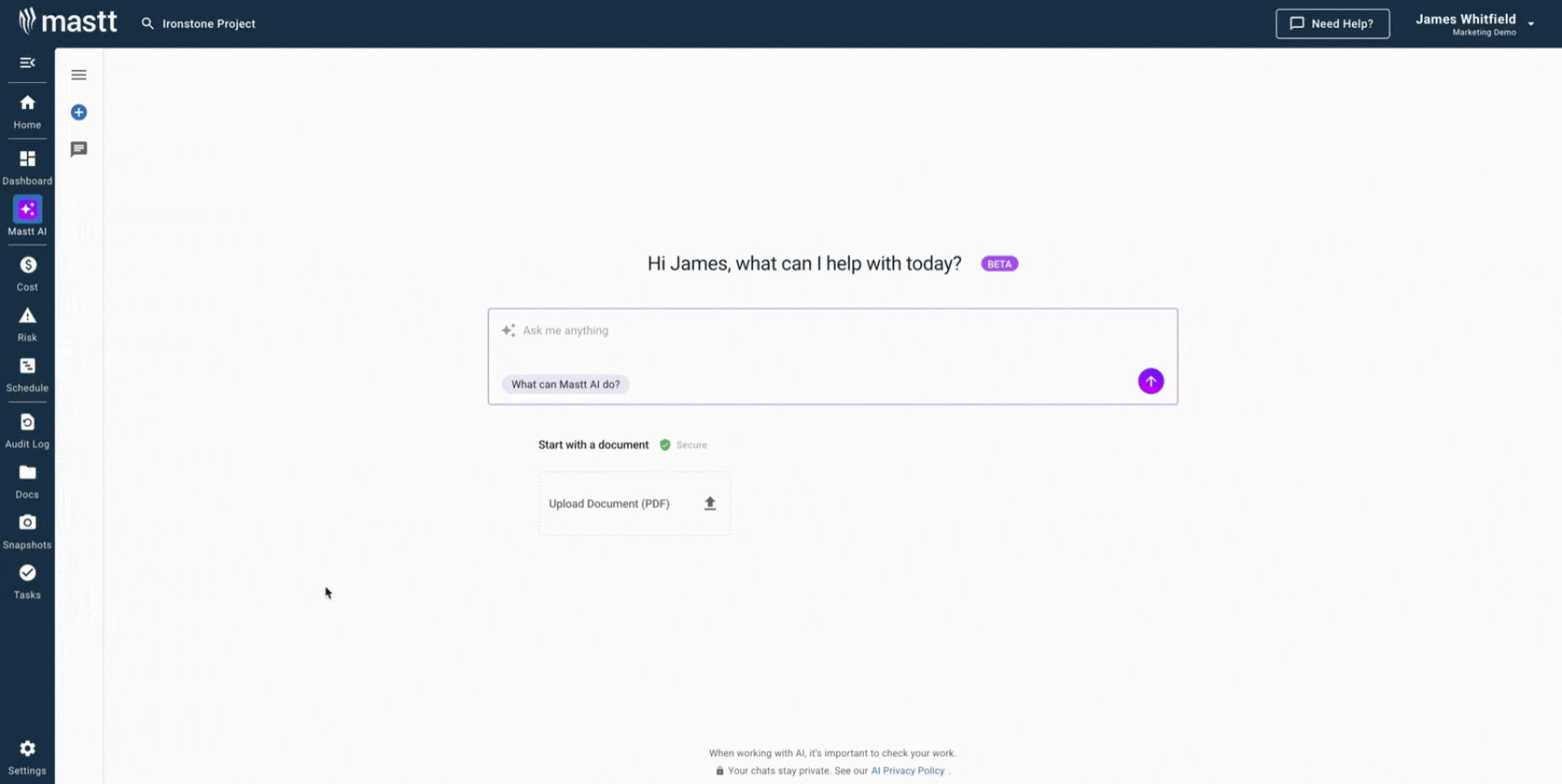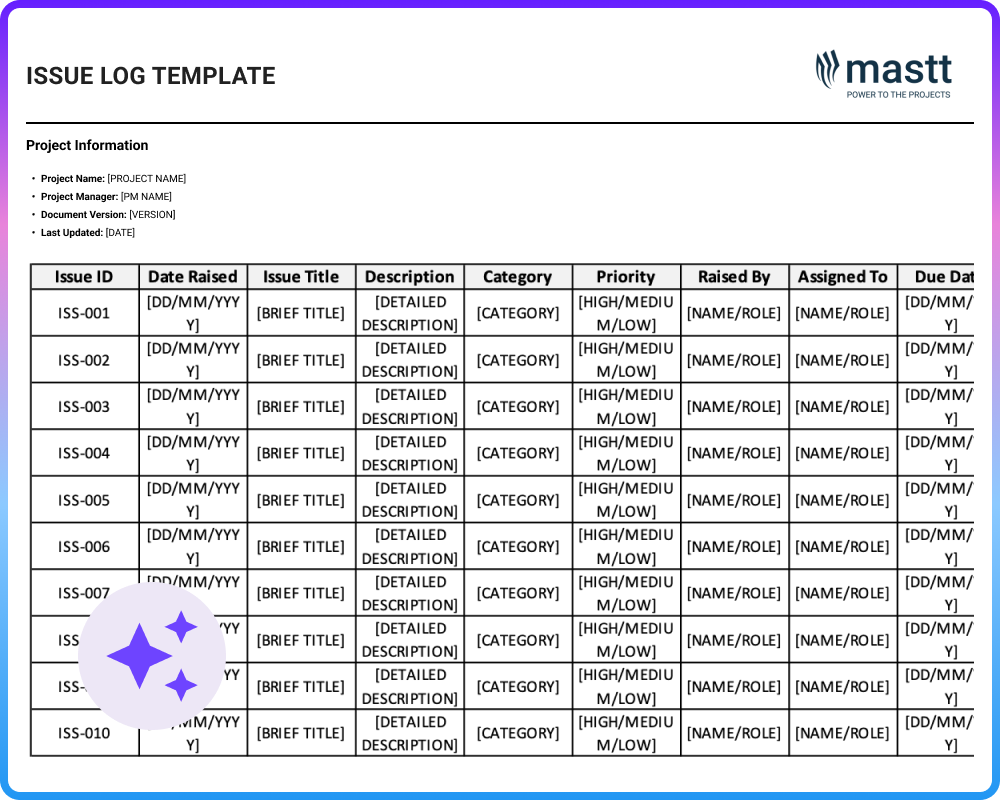What is an Issue Log Template?
An issue log template is a structured document used to capture, monitor, and resolve issues that arise during a project. In construction project management, the template acts as a central record where project managers, owners, and contractors can log problems such as design errors, site delays, or material shortages.
The main purpose of an issue log is to ensure that every issue is documented with clear ownership and a timeline for resolution. Instead of relying on scattered notes or emails, a template creates one consistent system for tracking accountability and maintaining project momentum.
What’s Included in Issue Log Templates?
Issue log templates include all the essential fields needed to document, assign, and resolve project issues effectively. The template typically includes an issue identification number or reference code that provides unique tracking for each recorded problem.
A well-structured issue log template typically contains:
- Issue ID/Reference Number: A unique identifier for each issue.
- Date Raised: The day the issue was first recorded.
- Issue Description: A clear and concise explanation of the problem.
- Category/Type: Classification such as design, contract, safety, scheduling, or quality.
- Impact Assessment: A summary of how the issue affects time, cost, or project quality.
- Assigned Owner: The team member or contractor responsible for resolving the issue.
- Priority Level: Categorized as low, medium, high, or critical.
- Current Status: Progress stage, such as open, in review, in progress, resolved, or closed.
- Target Resolution Date: The expected completion date for resolving the issue.
- Actual Resolution Date: The date the issue was formally closed.
- Resolution Notes/Comments: Provide additional context on actions taken or indicate follow-up required.
Whether you are using an issue log template in Excel, Word, or Google Sheets, these fields ensure no critical detail is overlooked. The more comprehensive the log, the easier it is for stakeholders to make informed decisions and prevent recurring problems.
Why Use a Template for Issue Log Management?
Using a template for issue log management ensures consistency, clarity, and accountability across construction projects. A standardized issue log helps project teams streamline communication and decision-making.
Key reasons to use an issue log template include:
- Consistency in documentation: Every issue is recorded in the same format, making it easier to review and compare.
- Improved accountability: Assigning responsibility in the log makes it clear who owns the resolution.
- Efficient reporting: Templates streamline the process of generating progress reports for clients, stakeholders, or regulators.
- Faster decision-making: With impact, priority, and status captured in one place, project managers can act quickly.
- Reduced disputes: A documented trail of issues supports changes and contract administration.
- Time savings: Instead of formatting from scratch, teams can focus on resolving issues.
- Adaptability across formats: Whether using an issue log template in Excel, Word, or Google Sheets, the structured layout works for projects of any size.
Issue logs often play a critical role in dispute resolution and payment management. Having a well-maintained log makes it easier to demonstrate how problems were identified, tracked, and resolved throughout the project life cycle.
Who Should Use an Issue Register Template?
An issue register template is designed for anyone responsible for overseeing, documenting, or resolving issues during a construction project. Using a structured register ensures that problems are captured early, assigned to the right people, and resolved within deadlines.
Key roles that benefit from an issue register template include:
✅ Project Owners: Gain visibility over project risks and confidence that issues are being managed properly.
✅ Project Managers: Track accountability, assign tasks, and monitor issue resolution progress.
✅ Contract Administrators: Use the register to document issues that may affect claims, variations, or contract compliance.
✅ Site Engineers and Supervisors: Record on-site issues in real time, ensuring they are not overlooked.
✅ Consultants and Designers: Track design-related issues or approvals that impact construction schedules.
✅ Contractors and Subcontractors: Document operational or resource-related challenges for transparency.
💡 Pro Tip: Share a filtered version of the issue register with clients or stakeholders to maintain transparency without overwhelming them with internal notes.
How to Use an Issues Log Template for Construction
Begin using an issue log template by establishing clear procedures for issue identification and reporting within your project team. Define who has authority to log issues, what constitutes a reportable problem, and the timeframes for initial documentation and status updates.
To use an issue log effectively:
- Record the issue immediately: Log issues as soon as they arise on-site, in meetings, or during inspections.
- Provide detailed descriptions: Include enough context for others to understand the issue without needing extra clarification.
- Categorize the issue: Classify whether the problem relates to design, safety, schedule, quality, or contractual matters.
- Assign responsibility: Clearly identify the owner responsible for resolving the issue.
- Set deadlines: Establish a realistic target resolution date to keep momentum.
- Update status regularly: Reflect progress by marking issues as open, in review, in progress, resolved, or closed.
- Document the resolution: Record the outcome and lessons learned once the issue is closed.
💡 Pro Tip: Integrate your issue log template with schedules and risk registers. Linking issues with risks and milestones helps project teams understand the broader impact of unresolved problems.
Customize Your Construction Issue Log Template with Mastt AI
Mastt AI takes the complexity out of managing project issues by generating a tailored issue log template in seconds. Instead of building one from scratch in free Excel, Word, or Google Sheets templates, you can request a ready-to-go format designed around the unique needs of your construction project.
Here’s what you can do with Mastt AI right away:
⚡ Generate issue log templates instantly: Create structured logs with fields for issue ID, description, owner, impact, and resolution dates.
📊 Customize the layout for your project: Adjust columns and categories to match project-specific requirements such as contract administration, site safety, or scheduling.
📂 Export in multiple formats: Download your issue log template in Excel or Word, ready for immediate use by your project team.
Mastt AI uses industry-aligned project management standards to ensure the issue log is complete, practical, and aligned with how construction teams actually work.
Here’s how to get started with Mastt AI:
- Type a request: Ask “create an issue log template” in the chat.
- Refine the template with AI: Add or remove fields like impact assessment, subcontractor notes, or resolution status until it fits your workflow.
- Export your log: Save the template in Excel, Word, or Google Sheets for easy collaboration and updates.
With Mastt AI, every chat stays private and secure, giving you full control over how your issue log templates are created, customized, and shared across the team.
👉 Explore more tips in our Help Center and start building your issue log template with Mastt AI today.

When to Use a Project Issue Log Template
An issues log template should be used throughout the entire lifecycle of a construction project to capture and resolve problems in a structured way. From early planning through to handover, the log ensures that issues are documented, assigned, and tracked until closure.
Key points where an issue log template is most valuable include:
- Design and Planning Stage: Record client queries, design errors, or approval delays that can impact later phases.
- Procurement Stage: Track supplier issues, late deliveries, or contract disputes.
- Construction Stage: Document site challenges such as safety incidents, material shortages, or weather delays.
- Testing and Commissioning: Capture defects, incomplete work, or technical faults before handover.
- Handover and Close-Out: Ensure all outstanding issues are resolved before issuing final certificates.
💡 Pro Tip: Review the issue log alongside the risk register during progress meetings. This helps distinguish between potential risks and active issues, ensuring both are managed effectively.
Common Problems with Issue Log Templates in Excel or Spreadsheets
A free downloadable issue log template can work well for small construction projects, but it quickly shows limitations as the project grows. Static issue logs become harder to manage with multiple stakeholders, often resulting in errors, outdated records, and version control issues.
Common challenges include:
- Incomplete data entry: Team members may skip filling out fields in a free issue log template in Excel or Word, leaving important ownership or impact details unclear.
- Version control issues: Multiple users editing the same issue log template in Google Sheets or Excel can create conflicting versions of the log.
- Limited scalability: A project issue log template designed for a small job may not scale when hundreds of issues need to be tracked across a large project.
- Lack of automation: Spreadsheets don’t automatically flag overdue issues or send reminders, which makes them less effective than more advanced tools.
- Poor visibility: Without dashboards or reporting features, even a well-maintained issue log template in Word or Excel may not give stakeholders a clear overview of critical issues.
For small projects, a free issue log template in Excel or Word can still provide structure. But for complex construction projects, relying solely on spreadsheets increases the risk of missed issues and poor accountability.
Bring Order to Issue Tracking with Mastt AI
Managing project issues shouldn’t rely on chasing multiple spreadsheets or patching together free templates. Mastt AI builds a tailored issue log template in seconds, with fields designed for construction, covering accountability, impact, and resolution dates from the start.
With every template created in a private, secure workspace, your team can stay aligned without worrying about lost files or outdated versions.
👉 Start building your issue log template with Mastt AI and bring structure to every issue before it becomes a delay.






.avif)

